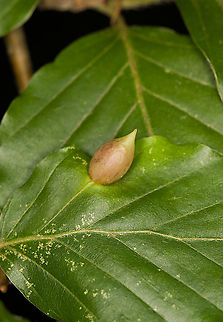
Appearance
Leaves of beech trees attacked by M. fagi show a marked diminution in leaf size and reduction of height and diameter growth as compared with uninfested trees. Heavy infestation of young beech trees by M. fagi may can lead to growth-inhibition due to the loss of assimilation ability (Holdheide, 1942; Paclt, 1973).M. fagi is one of eight gall midge species which are important pests of forest trees in Europe. This information was obtained by comparative studies of 44 species of the family Cecidomyidae on 20 forest trees at 1200 localities in the Czech Republic, Slovakia and Austria. M. fagi sometimes causes very high losses of assimilation surface of leaves (Skuhravá and Skuhravý, 1992; Skuhravý and Skuhravá, 1993; 1996).
References:
Some text fragments are auto parsed from Wikipedia.
http://www.plantwise.org/KnowledgeBank/Datasheet.aspx?dsid=34101